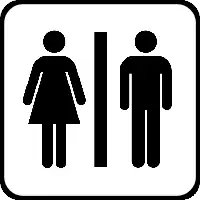AIGA符号
AIGA符号是美国交通部(DoT, Department of Transportation)和美国设计师学会(AIGA, American Institute of Graphic Arts)共同制定的一种不需要口头语言便能表达有用信息的符号。举例来说:现在广为人知的厕所和电话的标志。自从在1974年推出以来,它们不止被广泛应用于美国的飞机场、火车站、酒店和其它公众场所,也被世界上很多地方所采用。因为其普遍被人们接受,有些人把它们称为象形符号中的“Helvetica字体”,在某些地方则被称为“人形Helvetica”。

电话标志/AIGA符号

厕所标志/AIGA符号
历史
1974年,美国交通部发现使用在美国州际高速公路系统上的象形符号有缺陷,便委托美国设计师学会设计一套完整的象形符号集。在与库克和商诺斯基联合公司(Cook and Shanosky Associates)的合作下,设计师对在世界上已经使用的象形符号进行了彻底的调查,其中包括1972年慕尼黑奥运会。设计师们把象形符号按易读性、国际辨认度和用户抵制程度几项标准评估。在确定哪项功能最成功和合适后,设计师们按美国交通部的需求绘制了一套34个不同意思的象形符号。
到了1979年,又添加了16个符号,使符号总数达到了50个。
参考文献
- 《Design Writing Research: Writing About Graphic Design》;Ellen Lupton和J. Abbot Miller;New York: Kiosk, 1996年
- 《Symbol signs, 2nd ed》;American Institute of Graphic Arts for the U.S. Department of Transportation;New York: American Institute of Graphic Arts, 1993年
参见
外部链接
- AIGA设计的标志符号页面存档备份,存于:英文
This article is issued from Wikipedia. The text is licensed under Creative Commons - Attribution - Sharealike. Additional terms may apply for the media files.